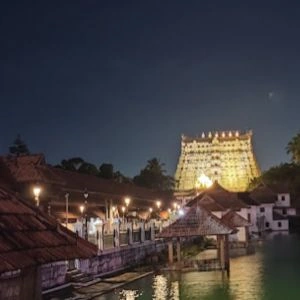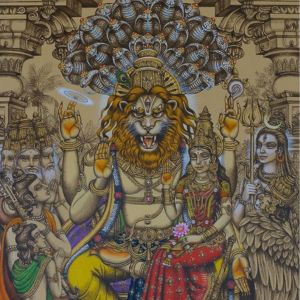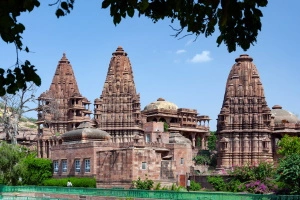Anantha Padmanabha Swamy Temple - Fascinating Legends

Discover the fascinating legends behind the Anantha Padmanabha Swamy Temple, one of the most revered temples in India. Explore its rich history and cultural significance in this article.
The Anantha Padmanabha Swamy Temple is a magnificent Hindu temple located in the heart of Thiruvananthapuram, the capital city of Kerala, India.
This ancient temple, which is dedicated to Lord Vishnu, is considered one of the most sacred and significant pilgrimage sites for Hindus.
The temple's history dates back to several centuries, and it is known for its stunning Dravidian architecture, intricate carvings, and exquisite sculptures.
The Anantha Padmanabha Swamy Temple is not just a great place of worship but also a testament to the rich cultural heritage of India.
Legend of Anatha Padmanabha Swamy
Vilwamangalam Swamiyar was a great saint of Kerala. Lord Krishna was visible to him.
Whenever he did his daily puja, Bhagawan used to come in the form of a mischievous young boy and trouble him a lot lovingly.
One day, when the naughtiness went beyond all limits, Swamiyar pushed Bhagawan away with his hand saying, 'Go away from here.'
Bhagawan was offended.
He said, 'I am going, if you want to see me again, come to Ananthankadu (Anatha forest).
As soon as Bhagawan disappeared, Swamiyar had deep regret for what he had done.
He started looking around for Bhagawan.
Nobody knew where Ananthankadu was.
One day, he was going through a village still looking for Bhagawan.
From a nearby hut, he overheard a man shouting at his wife, 'If you don't keep quiet, I will throw you into Ananthankadu.'
Swamiyar went and asked the man whether he knew where Ananthankadu was.
The man took Swamiyar there.
There, Swamiyar got the darshan of Bhagawan under a tree.
But it was not in the form of Balakrishna.
It was Bhagawan lying down with the serpent Anantha as his bed.
Lakshmi Devi was at his feet and Bhumi Devi was near his head.
Bhagawan told Swamiyar that he was hungry.
Swamiyar found some tender mangoes, crushed them, kept them in a coconut shell and offered them to Bhagawan.
Bhagawan became happy.
This particular offering is continued even today in Bhagawan's worship.
History of Anantha Padmanabha Swamy Temple
Ananthankadu was near the capital of the erstwhile capital of the State of Travancore.
Vilwamangalam Swamiyar informed the king of Travancore about the presence of Bhagawan in Ananthankadu.
The king got the place cleared and ordered to build a temple in 2152 BC.
The temple later succumbed to fire in the year 1686 CE.
King Marthanda Varma started reconstruction of the temple in 1724 which was completed in 1731 CE.
Specialty of the idol
The original idol of Anantha Padmanabha Swamy was made of wood.
It got destroyed in the fire.
When king Marthanda Varma was reconstructing the temple, the king of Nepal sent 24,000 Salagramas from the Gandaki River.
They were carried by elephants all the way from Nepal to Trivandrum.
Out of these, a sculptor called Balaranyakonidevan used 12,000 Salagramas to make the present idol.
A technique called Katu-Sarkara-Yogam has been employed to make this idol.
A mixture of 108 materials is processed and used for bonding of the Salagramas.
At that time, it was also decided that the daily offering to Anantha Padmanabha Swamy should comprise 12,000 handfuls of rice.
Traditional priests
The priests of Anantha Padmanabha Swamy Temple are Tulu Brahmins.
There are two priests, one from Pullur village in North Kerala and one from Kokkata village in South Karnataka.
They are descendents of the disciples of Vilwamangalam Swamiyar.
They alternate as the chief priest from month to month.
Once they become the priests of Anantha Padmanabha Swamy Temple, they are not allowed to prostrate before anyone or worship in any other temple.
They have to stay within the bounds of the temple complex throughout their tenure.
Padmanabha Swamy becomes the ruler of Travancore
As a gesture of their utmost devotion and surrender to the divine will of Anantha Padmanabha Swamy, the royal family of Travancore offered the entire kingdom at the Lord's feet.
This was done through a ritual called 'Trippadi-danam'.
King Marthanda Varma performed this in the year 1750 CE.
Thereafter, the royalty of Travancore ruled the kingdom as the servants of Swamy (Padmanabha-dasa).
The treasure at Anantha Padmanabha Swamy
Underground vaults of the temple contain a huge treasure of golden thrones, crowns, ornaments, diamonds, and other precious stones.
It is the largest collection of valuables in the world.
Out of the eight vaults named A,B,C,D,E,F,G, and H, three are unopened even now - B,G, and H.
According to news reports the estimated value of the treasure so far discovered is about 1 lakh crore rupees.
The treasure has been accumulated over thousands of years and given as gift by the various dynasties of South India.
Anantha Padmanabha Swamy Temple is a symbol of India's rich cultural and religious heritage and a fascinating destination for visitors seeking to explore the country's rich traditions and history.
Is photography allowed inside the Anantha Padmanabha Swamy Temple?
No, photography is not allowed inside the temple premises.
What is the dress code for visiting the Anantha Padmanabha Swamy Temple?
Visitors are required to dress modestly and conservatively. Men are required to wear dhoti or mundu (a traditional Indian garment) and are not allowed to wear shirts. Women are required to wear sarees or other traditional attire.
Quiz
Is Anantha Padmanabha Swamy Temple among the 108 Divya Desams?Recommended for you
Narasimha's Mantra for Ultimate Victory

Unlock the power of victory with the sacred Narasimha Mantra! In this transformative video, we present the potent Narasimha Mantra,....
Click here to know more..Mantra For Peace And Well Being

Mantra For Peace And Well Being - In Sanskrit, English, Hindi, Tamil, Malayalam, Telugu, Kannada - Benefits of listening every day - Reduces stress an....
Click here to know more..Akshaya Gopala Kavacham

shreenaarada uvaacha. indraadyamaravargeshu brahmanyatparamaa'dbhutam. akshayam kavacham naama kathayasva mama prabho.....
Click here to know more..
English Topics
Temples
Click on any topic to open
- 71 Ahobilam - Lord Narasimha's Sacred Abode
- 70 Malaikottai Temple, Trichy - Discover Spiritual Bliss
- 69 Jambukeswarar Temple, Trichy
- 68 Vaitheeswaran Koil - A Healing Pilgrimage
- 67 Dwaraka and Somnath
- 66 Khidkali Mahadev Mandir
- 65 Pongu Sani Temple, Thirukollikadu
- 64 The Unique And Fascinating Jharni Narasimhaswamy Temple, Bidar
- 63 Yamunotri: A Spiritual Haven in the Himalayas
- 62 Anantha Padmanabha Swamy Temple - Fascinating Legends
Please wait while the audio list loads..
30
Ganapathy
Shiva
Hanuman
Devi
Vishnu Sahasranama
Mahabharatam
Practical Wisdom
Yoga Vasishta
Vedas
Rituals
Rare Topics
Devi Mahatmyam
Glory of Venkatesha
Shani Mahatmya
Story of Sri Yantra
Rudram Explained
Atharva Sheersha
Sri Suktam
Kathopanishad
Ramayana
Mystique
Mantra Shastra
Bharat Matha
Bhagavatam
Astrology
Temples
Spiritual books
Purana Stories
Festivals
Sages and Saints
